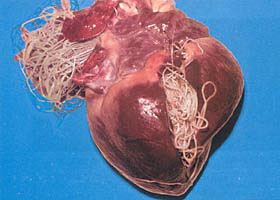Canine Heart Infected with Level 5 Heartworms
[Photo from Placerville Web Site; see also, American Heartworm Society]
Warning: Because of reports of adverse reactions, the FDA has pulled the ProHeart6 Injectable Heartworm Preventative from the Market.
See the advisory at http://www.fda.gov/bbs/topics/ANSWERS/2004/ANS01312.html
This article is designed to assist veterinarians in an on-going attempt to educate the public so that, together, we can help in the crusade against canine heartworm disease. We have learned a great deal about the disease through our experiences with heartworm patients and are happy to share this information; however, we stress that we are not veterinarians and always refer web site visitors to their own clinics.
In rescue work, we have realized that too many dog owners have no idea what heartworm disease is. They seem to think the disease is something microscopic in the heart, certainly not ‘real’ worms. They will even tell veterinarians their dog “doesn’t need” heartworm preventative. Other people think that if they keep their dogs inside, mosquitoes can’t bite them: obviously, dogs have to go outside to eliminate, and obviously mosquitoes get into homes as well. Finally, some people think mosquitoes cannot bite long-haired or thick-coated dogs. Despite all these myths, we have treated dozens of dogs for heartworm disease who had uninformed owners like these. The above graphic picture speaks volumes about canine heartworm disease (Dirofilaria immitis), and even more about the misery this poor dog must have experienced before his death. In its advanced stages (levels 3 – 5 [heavy infestation; the heart is ‘loaded’ with worms]), Caval Syndrome (worms cross over the vena cava), and DIC (‘disseminated intravascular coagulation’ when the blood cannot clot normally), this disease involves up to 100 6-inch to14-inch adult worms. They fill the heart, impede the blood supply, and in final stages, cross over into the arteries and lungs, shutting off oxygen, shutting down major organs, and in many cases breaking up and causing an embolism and blood clots. All the while, these worms are breeding within the dog, producing microfilariae that are picked up by mosquitoes and carried off to infect other unprotected dogs. Due to the ignorance and neglect of too many dog owners, heartworm disease has become epidemic in the United States; and it has also become an extremely painful, agonizing death for too many innocent dogs who trusted their owners to take care of them.
Canine heartworm disease is the single most preventable disease in dogs. Nevertheless, it is the major disease that kills our rescued Collies, especially in the South where we have the environmental conditions–high humidity, numerous waterways and coastlines–that allow for heavy incidence of mosquitoes, which carry the microfilariae (that become larvae in this stage) that infect the dogs. However, don’t believe the myth that northern regions are free of heartworm disease: it has been found in all fifty states. The American Heartworm Society, which is probably the most informative heartworm disease site on the Web, provides a map with the incidence of the disease throughout the United States. The site also provides information about preventatives and treatments. We’ve added others as well so our visitors interested in helping to educate themselves and others about the disease may learn all they can about it. We estimate that one-third of our rescues in SE Texas have the disease in various stages (Levels 1-5), and we’re seeing an increase in the numbers. The treatment with an adulticide (usually an Immiticide injection given in two-three doses, though in some cases vets and rescuers are using small, regular doses of Heartgard though HCR cautions the use of Ivermectim products due to some Collies have Ivermectim sensitivity Ivermectin Toxicity in Collies) saves 90% of them, and they go on to live full, happy lives in their new homes. But treatment, which is extremely expensive even for rescuers, usually cannot save dogs in the most advanced stages, and the treatment is itself often fraught with complications from nausea and soreness, to emergency care for vomiting and breathing difficulties. Even after treatment is successfully completed, we recommend the dog still not play or go for long walks for another month. Each heartworm patient should be kept quiet during treatment and be allowed to gradually build his or her strength in the weeks following. After successful completion of the treatment, dogs should be re-tested in 4-6 months. Also, dogs adopted from shelters that have tested the dogs for heartworms, with a negative result, should be re-tested by the new owner’s clinic: sometimes these tests are false negatives. If the 2nd test is also negative, test again in 4-6 months to make sure.
The pills that prevent heartworm disease (kill the microfilariae in the bloodstream) cost no more than a couple of rental movies a month, and in some cases, vets are willing to work with their clients in order to provide the pills more economically. Also helping the expenses are new pills and topical treatments that combine to kill heartworms and other parasites such as fleas, hookworms, mange, and ticks. HCR recommends Sentinel (Combination HW & Flea control flavored pill) or Interceptor along with a topical flea prevention such as Frontline, Advantage, Advantix, Biospot, etc.) Talk with your veterinarian about the best and most economical preventatives for your dog.
Please read all you can about heartworm disease and share these sites with others. If you know of dog owners not giving the pills, let them see the pictures and read about the disease on these sites, in hopes their ignorance about it can be turned around and their compassion ignited. If they still are not willing to give the pills, then ask them to relinquish the dog to rescue, so he or she might be saved before the condition becomes like the one for the dog above who died so horribly.
Please Note: Since we’ve seen the tragic effects of heartworm disease first hand, both in painful treatments for too many of our dogs and even more painful losses of precious dogs who were denied the very pills that would prevent the disease, we do not support the use of homeopathic treatments using wormwood, black walnut, citronella sprays, and the like. We do know that the prescribed preventatives work, and we do not experience the alleged ‘side effects’ the holistic proponents claim. In our rescue program of members and adoptive homes, we all have healthy dogs, many well into their senior years, all of them on lifelong heartworm preventative. Do not believe the claim that veterinarians and pharmaceutical companies are involved in ‘heartworm hype.’ There is no hype: heartworm disease is epidemic, and it is a killer that cannot be waved off with sprays and oils. What veterinarians, pharmaceutical companies, and rescue groups are doing is saving lives.
Additional Links to Internet Sites about Heartworm Disease
Many of these sites have graphic photos; others have diagrams of the heartworm disease cycle; all have valuable information about the disease, preventatives, and treatments. Links open in a new tab or window.
Diagnosis of Heartworm Disease
Canine Heartworm Disease(1)
The Pet Center
Heartworms
Pet’s Health
Canine Heartworm Disease(2)
Canine Heartworm Disease(3)
Dog Owner’s Guide
About.com – Heartworm Disease
University Of Missouri – Canine Heartworms
This site is designed for our Foster Homes assisting our dogs going through treatment and not intended as medical advice for visitors, who must consult their own veterinarians. We wish to Thank Houston Sheltie Sanctuary for the use of this Information.


